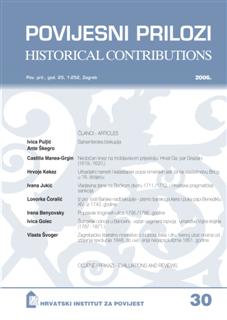Neobičan knez na moldavskom prijestolju: Hrvat Gašpar Graziani (1619.-1620.)
An Unusual Prince on the Moldavian Throne: Croat Gašpar Graziani (1619-1620)
Author(s): Castillia Manea-GrginSubject(s): History
Published by: Hrvatski institut za povijest
Keywords: Gašpar Graziani; Moldavia; the Ottoman Empire; Poland; Transylvania; seventeenth century
Summary/Abstract: Gašpar Graziani (1570/80?-1620), almost unknown in Croatian historiography. He was probably from the region of Bihać, although his real family name is not known. His name, along with the word “Croatian” can be commonly found in contemporary European and Ottoman sources. He was a highly positioned dignitary at the Porte and was engaged as a dragoman (translator). As such, Graziani was the main negotiator for the Ottoman side during the 1614-18 peace negotiations with the Hapsburg Empire. As an Ottoman ambassador, Gašpar was dedicated to improving the status of Catholics in Ottoman Hungary and even corresponded with Pope Paul V (1605- 21), who appreciated his efforts. At the same time, Graziani was on good terms with the Catholic Hapsburgs. For example, he intercepted the letters of the Czech rebels addressed to the sultan, in the first phase of the Thirty Year War (1618-48) for them. Nevertheless, in 1616 the Porte rewarded Gašpar for his services with the dukedom of Naxos and the possession of Paros (in the Aegean Sea). In order to restore its domination over Moldavia, shaken by an anti-Ottoman revolt, the Porte also gave Graziani the Moldavian throne at the beginning of 1619. As a Moldavian prince, he attempted to become the main political actor in the region; to expand his rule over the neighbouring principalities, first of all over Transylvania (which was drawn in the Thirty Year War by its Protestant prince Gabriel Bethlen), but also over Wallachia. In order to achieve his goals, Prince Graziani allied with the Poles and revolted against the Ottomans. This brought about the disaster of the Polish and Graziani’s small army in autumn 1620 near Ţuţora (in Moldavia), in which even the Moldavian prince was killed. With the departure of Graziani as well as the pro-Polish oriented Movileşti (1616) from the Moldavian throne, the Porte gained full domination over Moldavia once again. In this way, the Ottomans “wiped out” the last consequences of the large-scale anti-Ottoman revolt in Wallachia, Moldavia and Transylvania led by the Wallachian prince Michael the Brave, during the Long War (1593-1606). It is true that the Ottoman Empire and Poland, even after the new war in 1621 followed by peace at Hotin, continued their rivalry for political domination on Lower Danube, although the Polish influence over Moldavia had started to diminish. Consequently, because only a short time had elapsed, Graziani’s anti-Ottoman revolt might have seemed a hazardous and fruitless enterprise to the Moldavian chronicler Miron Costin (1633- 91). Moreover, many Romanian historians considered Graziani an adventurer. Nevertheless, it is clear that through his action, Prince Graziani established himself as one of the anti-Ottoman oriented Moldavian rulers, whose over-all policy against the Porte was one of the factors which insured the autonomy of the Moldavian principality within the Ottoman Empire in those times.
Journal: Povijesni prilozi
- Issue Year: 2006
- Issue No: 30
- Page Range: 51-77
- Page Count: 27
- Language: Croatian

